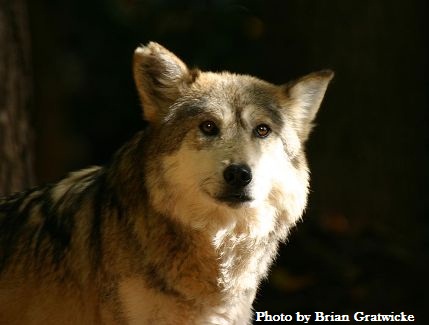In the News: Local Mexican gray wolf population remains low
 Matthew Smith, Good Morning El Paso
Matthew Smith, Good Morning El Paso
In early June, Federal officials declared a victory following a four-decade campaign to rescue the gray wolf.
It has been a long journey for the gray wolf. Once considered a dangerous predator by the government, there were attempts to exterminate the wolves.
This month, the U.S. Fish and Wildlife Service proposed removing the animal’s remaining protections as an endangered species across the Lower 48 states. The exception would be in the Southwest, where the recovery effort for the related Mexican gray wolf is lagging.
Dan Ashe, the agency’s director, said the wolf can thrive without further protection.
“Taking this step fulfills the commitment we’ve made to the American people — to set biologically sound recovery goals and return wolves to state management when those goals have been met and threats to the species’ future have been addressed,” said Ashe.
Right now the U.S. Fish and Wildlife Service is looking at efforts with the Mexican gray wolf, a subspecies that exists in Arizona and New Mexico.
“It’s still pretty bleak out there, so we need to get more people involved,” said Rick Lobello an El Paso zoo education curator.
Lobello works with two Mexican gray wolves, Ash and Ivy, which belong to the El Paso Zoo. A third wolf was removed from their exhibit in 2010 to allow for breeding.
“It’s really important that these animals return to the wild because they’re part of the ecosystem,” said Lobello. “They hold it all together.”
Right now, only 75 Mexican gray wolves exist in the wild.
Work is being done to reintroduce them. However Michael Robinson, the author of a book focusing on gray wolves “Predatory Bureaucracy,” says there are only three breeding pairs of Mexican gray wolves in the wild.
“The U.S. government has frozen releases of wolves, they’ve only released one wolf to the wild in about five years since 2008,” said Robinson.
According to the U.S. Fish and Wildlife Services, the agency is calling for tenfold increase in the territory where biologists are working to rebuild that population. Law enforcement efforts to ward off poaching in the region would be bolstered.
This story and a television video about the wolves was posted by ABC 7 KVIA.
********************************************************************************************************************************************
How to comment
Two proposed rules affecting Mexican gray wolves and all gray wolves were published in the Federal Register on June 13, 2013. Public comments will be accepted for 90 days from the date of publication through 11:59 p.m. on September 11, 2013. USFWS guidance on how to submit comments is provided here.
Points to include:
While giving Mexican wolves their own ESA listing is overdue, delisting gray wolves thoughout the lower 48 is premature and unsupported by science. The very scientists whose research is referenced in the draft rule to remove the gray wolves’ protections have stated that the science does not support the delisting.
A change that allows new Mexican wolves to be released directly into New Mexico instead of limiting new releases to Arizona is also long overdue. This will remove obstacles to getting new wolves and healthier genetics in the wild, where they are desperately needed.
Wolves don’t read maps. Mexican gray wolves should have the freedom to roam and boundaries on their movements should be eliminated.
The Fish and Wildlife Service should complete the Mexican gray wolf Recovery Plan; without a valid recovery plan, the agency is making important decisions without a road map
The Fish and Wildlife Service should give critically endangered Mexican wolves greater protections, including full endangered species protections, rather than extending the zone in which they can be killed or removed over livestock.
Delisting gray wolves throughout the U.S. is counter to protecting Mexican wolves. Fewer than 80 Mexican gray wolves exist in the wild. New populations of these wolves are desperately needed for them to thrive. But the draft plan would leave gray wolves unprotected in places where this endangered subspecies could and should live. This will make protection of Mexican gray wolves much more difficult should they expand into Utah or Colorado and make it unlikely that any wolves will be able to naturally reestablish a presence in the Southern Rockies, a region with excellent suitable habitat where wolves were once found.
Wolves are a benefit to the West and are essential to restoring the balance of nature.
Polling showed 77% of Arizona voters and 69% of New Mexico voters support the Mexican wolf reintroduction.
Wildlife biologists believe that Mexican wolves will improve the overall health of the Southwest and its rivers and streams — just as the return of gray wolves to Yellowstone has helped restore balance to its lands and waters.
Wolves generate economic benefits – a University of Montana study found that visitors who come to see wolves in Yellowstone contribute roughly $35.5 million annually to the regional economy.
To submit comments to the US Fish and Wildlife Service, go to http://www.regulations.gov. In the Search box, enter FWS—HQ—ES—2013—0073, which is the docket number for this rulemaking.
______________________________________________________________________
Click here to join our email list for Mexican gray wolf updates and action alerts.
Visit us on Facebook here.



